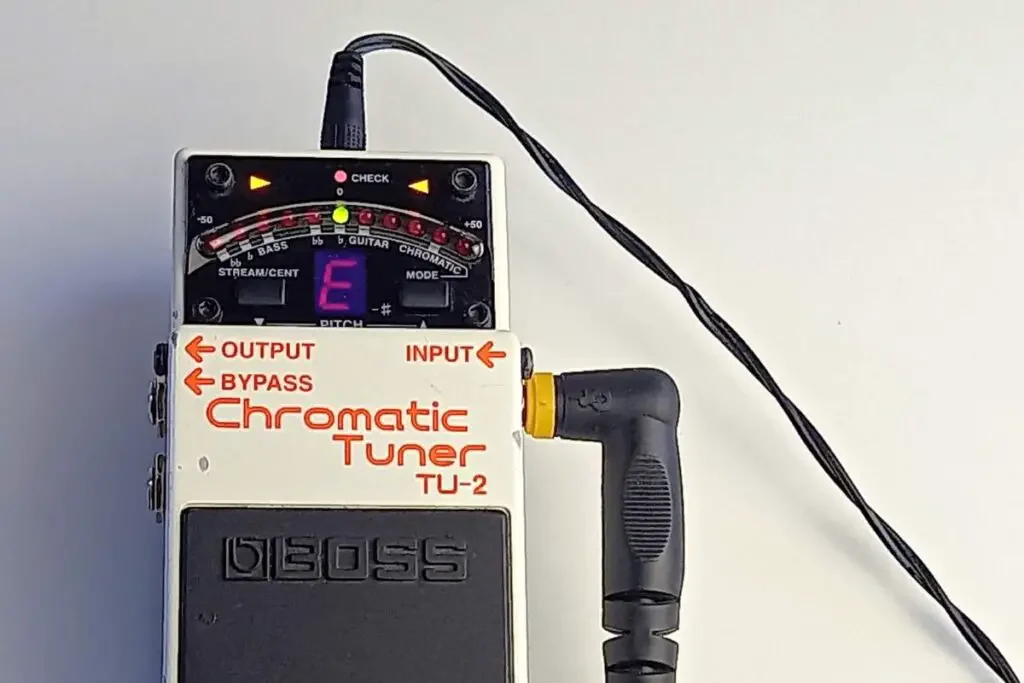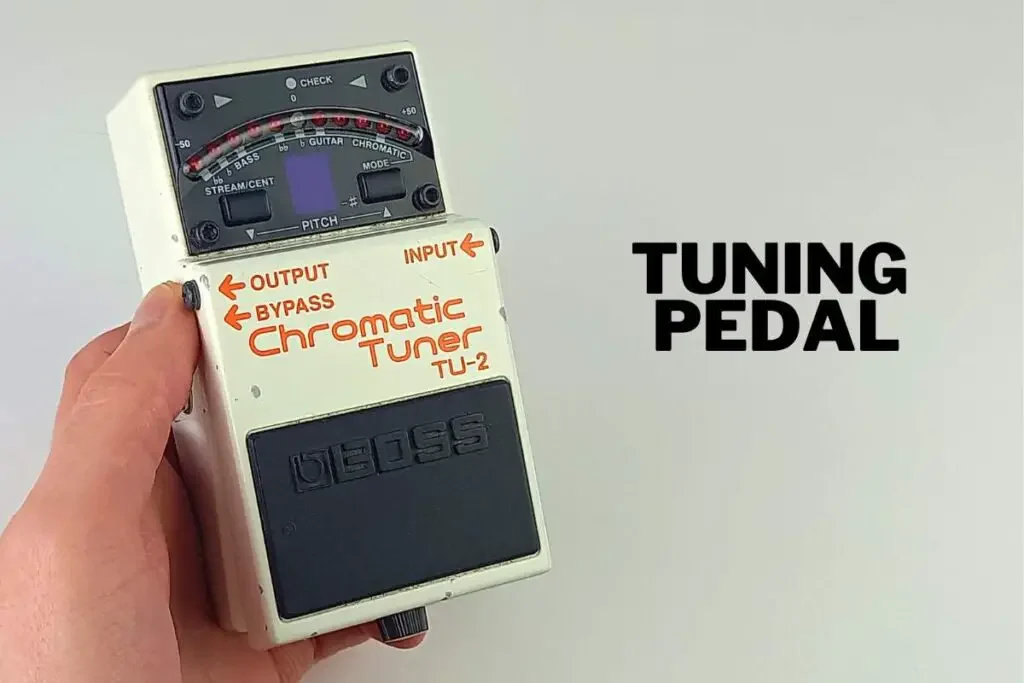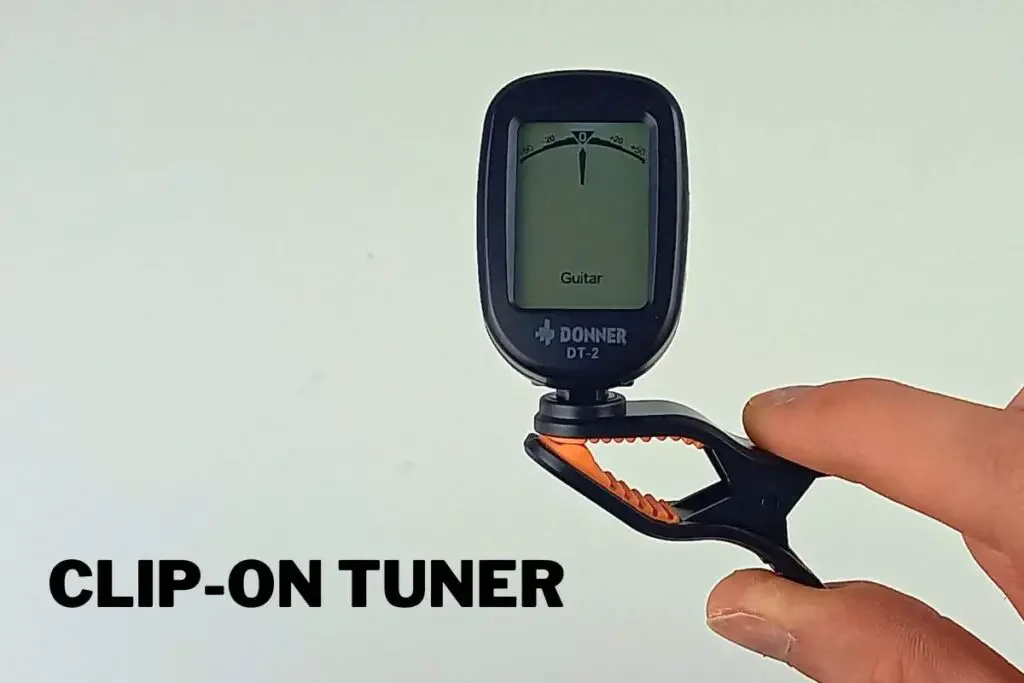A guitar tuner is an essential piece of gear for any guitarist – whether you’re a beginner or a pro. They’re a really useful tool that helps you to tune your guitar and keep it sounding good.
Though they may not be the most exciting piece of gear – I’d argue that a good quality guitar tuner is one of the most important things to own.
In this guide, I’ll cover the basics of guitar tuners, the different types of guitar tuners out there, and what they’re best for.
Affiliate disclaimer: This page contains affiliate links for products that I’ve tried and tested. As an Amazon Associate I earn from qualifying purchases at no additional cost to you. Learn more here.
What is a guitar tuner?
A guitar tuner is a device that shows you how in-tune your guitar is and helps you to bring it to the correct pitch.
It does this by measuring the pitch of your strings and showing you whether it’s lower (flat) or higher (sharp) than the intended note using a built-in display.

The type of display varies from tuner to tuner, but most tuners show you the current note in the middle of the screen and a scale either side to visualize how sharp or flat you are.
Most guitar tuners are chromatic, meaning that they can tune to any note. But, some tuners are non-chromatic which means that they’re locked to specific tunings, like E standard for example (E-A-D-G-B-E). I’ve found that this limitation is mostly common with tuning apps – although most tuners include the functionality to lock to a specific tuning.
Whether you’re practicing at home or playing live with a band; a guitar tuner is an essential piece of equipment for any guitarist.
Types of guitar tuners
There’s a range of different guitar tuners available. Each will help you to tune your guitar, but they all have their own strengths and weaknesses.
The important thing is to find a guitar tuner that works for you and your needs.
I own each of the below types of guitar tuner, so I’ve shared my thoughts on what they’re best at – based on my own experiences.
Guitar tuner pedals
Guitar tuning pedals work by taking a direct signal from your guitar and showing you clearly how in-tune it is. These usually have the easiest to read displays, as they’re intended to be on the floor when they’re on – so they need to be read at a distance!
With most tuning pedals, you’ll need to tune each string individually – though there are some polyphonic tuning pedals out there.
To me, guitar tuning pedals are the best type of guitar tuner in terms of accuracy as you plug your guitar straight into them. Though, they can be a bit of a hassle to set up, especially if you’re at home and just want to get playing.

In my experience, guitar tuning pedals are best for:
- Playing live
- Studio recording
- Professional musicians
A high-quality guitar tuning pedal is essential if you’re looking to play guitar live. It’ll give you a clear and accurate display, no matter what’s going on around you. They can also pass your guitar signal (and in some cases even power) onto guitar pedals further down the chain.
What’s more is that they’re turned on by pressing it with your foot, and they’ll mute your guitar’s output. All essential things for a live performance.
If you’re serious about playing guitar, I recommend picking up a pedal tuner. While they’re not the most fun pedal to buy, I’d argue that they’re the most useful to have.
I use the Boss TU-2, a slightly older model of the new Boss TU-3. It’s worked great for me over the years both live, at home, and in the studio. Honestly, this thing is built like a tank – it’s taken some heavy wear over the years and is still going strong! You can check out the latest price here on Amazon.
Clip-on guitar tuners
Clip-on tuners work by sensing the vibrations of your strings through your guitar’s headstock. No need for wires or needing a quiet space. You simply clip it on to the tip of the headstock, turn it on, and get tuning.
I’ve only started using a clip-on tuner in my 20th year of playing, and I have to say it’s really changed the way I tune my guitar. Before, I’d either have to sacrifice my time to set up my tuning pedal – or sacrifice some accuracy by tuning by ear.
With my clip-on tuner, I can just clip it on, tune up and get playing without any compromises.

I’ve found that clip-on guitar tuners are best for:
- Beginners or professionals
- Playing at home
- Acoustic guitarists
While my clip-on tuner is great, it doesn’t fully replace the need for a guitar pedal tuner. That’s because they’re not quite as accurate as a pedal tuner – though the difference isn’t too noticeable.
While you can use a clip-on tuner on stage, it’ll be less accurate the louder the venue is. Vibrations from the crowd, drums, or moving around can easily make it less precise.
I use the Donner DT-2 clip-on tuner. As I’ve said, I’ve found it to be really useful for practicing at home and quickly getting my guitar up to tune. It’s also a fraction of the price of a pedal tuner, which makes it a great first tuner for beginners. You can check it out here on Amazon.
Handheld guitar tuners
These pocket-sized tuners work by taking a direct signal from your guitar or by picking up the sound from a built-in microphone.
Having two different ways to tune makes handheld tuners very versatile – and very convenient to use. If you’re in a rush, you can just set it to microphone mode. But, if you want a more accurate tune, you can connect your guitar directly.
Some even come with additional features like tone generators, for tuning by ear, or metronomes.

In my experience, handheld guitar tuners are best for:
- Beginners
- Playing at home
While I have a handheld tuner, I’ve found that it’s been surpassed by my clip-on tuner. Both are similarly priced, but the clip-on is more convenient – especially for tuning quickly. The microphone can easily pick up background noise which makes it less accurate.
Even though it can take a direct signal from your guitar, and often output it too, they aren’t designed for live performances. The small display and hands-required controls will be tricky to use in low-light settings.
If you think a handheld tuner might be right for you, I recommend the Korg CA-50. It’s the one I use, and I’ve found it to be as accurate as my Boss TU-2, at a fraction of the price. You can check it out here on Amazon.
Guitar tuning apps
Tuning apps use your phone’s microphone to pick up the sound of your guitar and tell you how in-tune it is.
Most tuning apps will also include some added features like metronomes, tone generators, and even lessons.

I’ve found that guitar tuning apps are best for:
- Beginners
- As a backup tuner
While they’re microphone based (so not the most accurate) I’ve found that they’re really handy to have in a pinch. Lost your tuner, or just don’t have one nearby? Simply grab your phone and get your guitar back up to pitch.
There’s plenty of free options too, so you don’t have to spend any money to get started. I use the GuitarTuna app, which is free – but can be difficult to navigate sometimes with the ads.
Though they’re useful, I don’t think that tuning apps fully replace the need for a designated guitar tuner. Especially, if you’re set on performing live or in a studio. They only work if you have a quiet space to tune – which isn’t something you’ll get when you have a crowd cheering for you!
Final thoughts on guitar tuners
If you’re just getting started, then I’d recommend picking up a clip-on tuner. They’re very affordable and very useful – even as you start to become a more advanced player.
For any guitarist that wants to get out and play live, then a pedal tuner is a must have. They’re a bit pricier, but they’re more accurate and have features that are designed for live use.
Whichever one you choose: having a good-quality guitar tuner is essential for any serious guitarist.
Remember: there’s no point being the best guitarist if you’re always out of tune!

Conor is a music producer, multi-instrumentalist, and all-round enthusiast from the UK with over 15 years of experience. He’s the founder and sole-content creator for the roundtable audio blog and YouTube channel.
